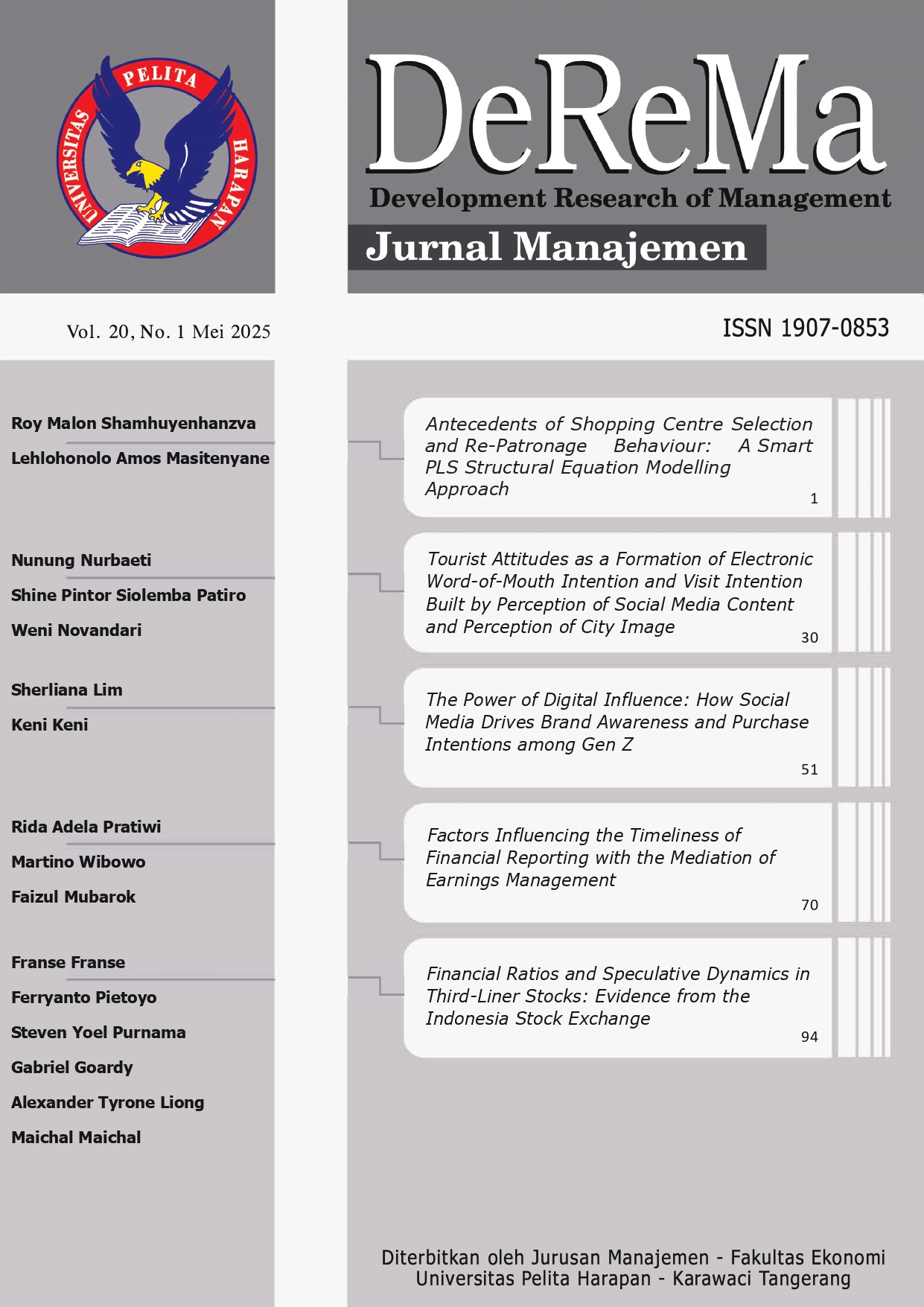THE POWER OF DIGITAL INFLUENCE: HOW SOCIAL MEDIA DRIVES BRAND AWARENESS AND PURCHASE INTENTIONS AMONG GEN Z
##semicolon##
https://doi.org/10.19166/derema.v20i1.9181##semicolon##
influencer credibility##common.commaListSeparator## user generated content##common.commaListSeparator## celebrity endorsement##common.commaListSeparator## Brand Awareness##common.commaListSeparator## purchase intention초록
This study explores the impact of influencer credibility, user-generated content (UGC), and celebrity endorsement on purchase intention among Generation Z in Jabodetabek, with brand awareness as a mediating variable. This study collected data from 186 respondents who were skincare products users and the data were analyzed by using Partial Least Squares-Structural Equation Modeling (PLS-SEM). The results indicate that UGC and brand awareness significantly and positively influence purchase intention. However, influencer credibility and celebrity endorsement do not affect purchase intention significantly. Furthermore, brand awareness does not mediate the impact of influencer credibility and celebrity endorsement on purchase intention. These findings highlight the importance of prioritizing user-generated content and brand awareness in shaping consumer’s purchase intention. Moreover, for skincare companies, focusing on authentic user interactions and fostering brand familiarity can enhance marketing strategies, particularly in competitive digital environments. Furthermore, this study offers insights regarding how digital marketing elements influence consumer’s behavior and provides feasible recommendations for businesses who target young and media-savvy customers. The results underline the evolving role of digital content and branding in driving purchase intentions, suggesting that companies should adapt their strategies to align with the expectations of Generation Z, who value relatability and authenticity.
##submission.citations##
Alim, A. S., & Budiarti, E. (2021). Peran iklan televisi dan celebrity endorsement Pond’s terhadap purchase intention. Jurnal Ekonomi Manajemen, 6(3), 83-100. https://doi.org/10.30996/jem17.v6i1.5277
Bolin, G. (2021). User-generated content (UGC). In G. Balbi, N. Ribeiro, C. Young, & C. Fox (Eds.), Digital roots (pp. 267–279). De Gruyter Oldenbourg.
Bougie, R., & Sekaran, U. (2020). Research methods for business: A skill-building approach (8th ed.). John Wiley & Sons.
Cahyadiningrum, T., & Rahardjo, S. T. (2023). Analisis pengaruh kredibilitas influencer pada Instagram terhadap minat beli dengan kepercayaan merek dan citra merek sebagai variabel mediasi (Studi pada perawatan tubuh Wardah). Diponegoro Journal of Management, 12(4), 1-9.
Chetioui, Y., Benlafqih, H., & Lebdaoui, H. (2020). How fashion influencers contribute to consumers' purchase intention. Journal of Fashion Marketing and Management, 24(3), 361–380. https://doi.org/10.1108/JFMM-08-2019-0157
Cheung, M. L., Pires, G., & Rosenberger, P. J. (2020). The influence of perceived social media marketing elements on consumer–brand engagement and brand knowledge. Asia Pacific Journal of Marketing and Logistics, 32(3), 695-720. https://doi.org/10.1108/APJML-04-2019-0262
Compas. (2024, September 2). Top Brand 2024 [Instagram post]. Instagram. https://www.instagram.com/compas.co.id/
Coomber, R., Childs, A., Moyle, L., & Barratt, M. (2023). Social media applications and ‘surface web’ mediated supply of illicit drugs: Emergent and established market risks and contradictions. In M. Tzanetakis & N. South (Eds.), Digital transformations of illicit drug markets: Reconfiguration and continuity (pp. 15-28). Publishing Limited.
Cuomo, M. T., Tortora, D., Giordano, A., Festa, G., Metallo, G., & Martinelli, E. (2020). User‐generated content in the era of digital well‐being: A netnographic analysis in a healthcare marketing context. Psychology & Marketing, 37(4), 578-587. https://doi.org/10.1002/mar.21327
Dewinta, A., Purnomo, B. B., Afifah, N., Barkah, & Marumpe, D. P. (2023). Influence of celebrity endorsement on purchase intention mediated by brand awareness of Skintific on Tiktok. Jurnal Ekonomi, 12(4), 1836-1845.
Enes, Y. D. S. O., Demo, G., Porto, R. B., & Zulato, T. S. (2024). What is next for consumer-based brand equity in digital brands? Research itineraries and new challenges. Sustainability, 16(13), 1-19. https://doi.org/10.3390/su16135412
Ezra, A., & Firdausy, C. M. (2024). The influence of celebrity endorsement on purchase intention of K-Meals McDonald's: The role of brand credibility. International Journal of Application on Economics and Business, 2(1), 3259-3268. https://doi.org/10.24912/ijaeb.v2i1.3259-3268
Farida, N., Purwianti, E., & Taufik, I. (2022). Pengaruh kredibilitas influencer terhadap minat beli subscribers pada channel YouTube otomotif Ridwan Hanif. Jurnal Ilmu Komunikasi, 36(1), 36-44. https://doi.org/10.53856/bcomm.v4i1.233
Hair, J. F., Black, W. C., Babin, B. J., & Anderson, R. E. (2019). Multivariate data analysis (8th ed.). Pearson Education Limited.
Hair, J., & Alamer, A. (2022). Partial least squares structural equation modeling (PLS-SEM) in second language and education research: Guidelines using an applied example. Research Methods in Applied Linguistics, 1(3), 100027. https://doi.org/10.1016/j.rmal.2022.100027
Han, J., & Balabanis, G. (2024). Meta-analysis of social media influencer impact: Key antecedents and theoretical foundations. Psychology & Marketing, 41(2), 394–426. https://doi.org/10.1002/mar.21927
Hamid, M. R. A., Sami, W., & Sidek, M. H. M. (2017). Discriminant validity assessment: Use of Fornell-Larcker criterion versus HTMT criterion. In 1st International Conference on Applied & Industrial Mathematics and Statistics 2017 (1–5). https://doi.org/10.1088/1742-6596/890/1/012163
Henseler, J., Hubona, G., & Ray, P. A. (2015). Using PLS path modeling in new technology research: Updated guidelines. Industrial Management & Data Systems, 116(1), 2-20. https://doi.org/10.1108/IMDS-09-2015-0382
Herrando, C., & Martin-De Hoyos, M. J. (2022). Influencer endorsement posts and their effects on advertising attitudes and purchase intentions. International Journal of Consumer Studies, 46(6), 2288-2299. https://doi.org/10.1111/ijcs.12785
Kamins, M. A. (1990). An investigation into the “match-up” hypothesis in celebrity advertising: When beauty may be only skin deep. Journal of Advertising, 19(1), 4-13. https://doi.org/10.1080/00913367.1990.10673175
Kelman, H. C. (1958). Compliance, identification, and internalization: Three processes of attitude change. Journal of Conflict Resolution, 2(1), 51-60. https://doi.org/10.1177/002200275800200106
Lou, C., & Yuan, S. (2019). Influencer marketing: How message value and credibility affect consumer trust of branded content on social media. Journal of Interactive Advertising, 19(1), 58–73. https://doi.org/10.1080/15252019.2018.1533501
Malhotra, N. K. (2020). Marketing research: An applied orientation (7th ed.). Pearson Education.
Martiningsih, D. A., & Setyawan, A. A. (2022). The impact of influencers’ credibility towards purchase intention. In International Conference on Economics and Business Studies (pp. 196-204). https://doi.org/10.2991/aebmr.k.220602.025
Muthuswamy, V. V. (2023). Influencer credibility and purchase intention: Mediating role of brand awareness. Transnational Marketing Journal, 11(1), 213–228. https://doi.org/10.58262/tmj.v11i1.1015
Nhuong, B. H., & Truong, D. D. (2024). Impacts of integrated marketing communications on customers’ green brand awareness: An empirical case study in Vietnam. Environmental Research Communications, 6(7), 1–16. https://doi.org/10.1088/2515-7620/ad54a3
Paramhita, A. S. K., & Purnamie, N. M. (2019). The role of brand awareness mediates the relationship credibility between endorser and online purchase intention through online shopping site Bukalapak.com. Manajemen dan Bisnis, 18(2), 35–45. https://doi.org/10.24123/jmb.v18i2.346
Pitoyo, A. A., & Marlien, R. A. (2023). Faktor-faktor yang memengaruhi minat beli dengan brand awareness sebagai variabel intervening. Management Studies and Entrepreneurship Journal (MSEJ), 4(6), 9415–9424. https://doi.org/10.37385/msej.v4i6.2870
Pradhan, D., Kuanr, A., Pahi, S. A., & Akram, M. S. (2023). Influencer marketing: When and why Gen Z consumers avoid influencers and endorsed brands. Psychology & Marketing, 40(1), 27–47. https://doi.org/10.1002/mar.21749
Putri, V. J. (2020). Pengaruh user-generated content (UGC) dan kualitas produk terhadap minat beli konsumen Dapur Mbok Sarminah. Jurnal Performa: Jurnal Manajemen dan Start-up Bisnis, 5(2), 95–102. https://doi.org/10.37715/jp.v5i1.1536
Sesar, V., Martincevic, I., & Boguszewicz-Kreft, M. (2022). Relationship between advertising disclosure, influencer credibility, and purchase intention. Journal of Risk and Financial Management, 15(7), 1-21. https://doi.org/10.3390/jrfm15070276
Setyowati, A., Chung, M. H., Yusuf, A., & Haksama, S. (2020). Psychometric of the curiosity and exploration inventory-II in Indonesia. Journal of Public Health Research, 9(3), 294-298. https://doi.org/10.4081/jphr.2020.1745
Siregar, E. P., & Saktiana, G. M. (2024). Pengaruh penggunaan Rayyanza Malik Ahmad (Cipung) sebagai endorser terhadap minat beli konsumen. Jurnal Manajerial dan Kewirausahaan, 6(3), 681-696. https://doi.org/10.24912/jmk.v6i3.31601
Spry, A., Pappu, R., & Cornwell, T. B. (2011). Celebrity endorsement, brand credibility and brand equity. European Journal of Marketing, 45(6), 882-909. https://doi.org/10.1108/03090561111119958
Wafiyah, F., & Wusko, A. U. (2023). Pengaruh user-generated content dan e-WOM terhadap purchase intention dan purchase decision pada pembeli produk Nyrtea di Instagram. Jurnal Ekonomi, Bisnis, dan Manajemen, 2(3), 190–200. https://doi.org/10.58192/ebismen.v2i3.1278
##submission.downloads##
출판됨
권
세션
##submission.license##
##submission.copyrightStatement##
##submission.license.cc.by-sa4.footer##Authors who publish with this journal agree to the following terms:
1) Authors retain copyright and grant the journal right of first publication with the work simultaneously licensed under a Creative Commons Attribution License (CC-BY-SA 4.0) that allows others to share the work with an acknowledgement of the work's authorship and initial publication in this journal.
2) Authors are able to enter into separate, additional contractual arrangements for the non-exclusive distribution of the journal's published version of the work (e.g., post it to an institutional repository or publish it in a book), with an acknowledgement of its initial publication in this journal.
3) Authors are permitted and encouraged to post their work online (e.g., in institutional repositories or on their website). The final published PDF should be used and bibliographic details that credit the publication in this journal should be included.





